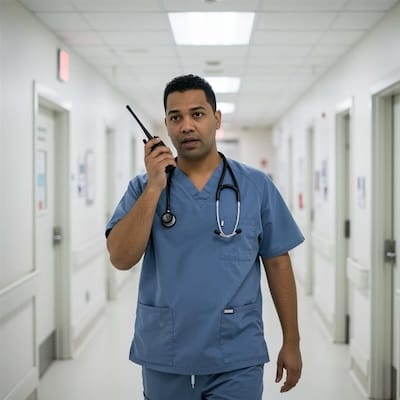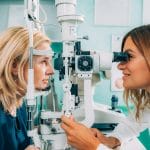Two-way radios may not always be the most visible technology in a healthcare setting, but in rural communities, they are often the quiet lifeline that keeps medical staff connected when it matters most. Unlike high-profile medical equipment such as ventilators, diagnostic imaging systems, or electronic health records, radios do not sit at the center of patient charts or treatment headlines. Yet without them, day-to-day operations, particularly in isolated areas, could stall.
In regions where cellular coverage drops to a single bar and internet service can be unreliable, radios step in to bridge critical communication gaps. For healthcare systems facing the dual challenges of long distances and unpredictable conditions, the reliability and immediacy of two-way communication becomes as important as medical supplies or trained personnel. Radios ensure that vital messages—whether about an incoming trauma patient, a resupply of IV fluids, or a changing weather condition—are transmitted instantly and clearly.
The Communications Lifeline in Rural Healthcare
Rural healthcare systems differ from their urban counterparts in far more than population density. Facilities such as small community clinics, regional hospitals, and mobile medical units are often widely dispersed across many miles of farmland, mountains, or forested terrain. Inefficient communication could delay ambulance coordination, transfer protocols, or specialty consultations.
This geographic separation makes two-way radios indispensable tools. Unlike mobile phones or email systems that require infrastructure support and stable connectivity, radios operate independently of carrier networks. When a storm knocks out fiber internet lines or an ice storm disrupts power, radios still function, powered by long-lasting batteries and repeaters that extend range across difficult terrain.
Furthermore, communication over a two-way radio is instantaneous. Staff do not have to unlock a device, pull up a contact, wait for a call to connect, or risk voicemail delays. Instead, with a simple push of a button, an entire network of staff can hear, respond, and act in seconds. In healthcare, where minutes can decide outcomes, this immediacy is irreplaceable.
Everyday Use Cases of Radios in Rural Healthcare
The daily workflow in rural medical environments relies heavily on practical, efficient communication. Radios directly support:
- Ambulance Dispatch & Emergency Transfers
- Crews en route to local clinics or regional trauma centers can stay in constant contact with ER staff. For instance, handheld digital radios such as the Motorola MOTOTRBO R7 offer crystal-clear audio—even in noisy ambulance environments—ensuring no critical detail is missed during a hand-off.
- Supply Chain and Logistics
- From medical oxygen to vaccine shipments, rural healthcare facilities depend on precise timing and delivery. Radios support logistics teams by enabling on-the-spot coordination, reducing reliance on phone lines that might be oversaturated during crises.
- Disaster & Severe Weather Response
- Floods, blizzards, or tornadoes can isolate facilities physically and digitally, cutting off phone lines or mobile networks. Radios, especially when paired with on-site repeaters such as the Motorola SLR 5700 repeater, guarantee extended coverage when it’s most critical.
- Staff Coordination Across Facilities
- For multi-site rural health organizations, radios provide a unified communication layer across multiple clinics or urgent care centers, helping administrators and clinicians remain synchronized on staffing needs and patient transfers.
Technology in Action: Modern Digital Radios
Earlier generations of radios were often categorized as simple analog walkie-talkies, offering basic push-to-talk functionality. However, today’s digital two-way radio systems are much more sophisticated—capable of encryption, integration with hospital communication networks, and seamless compatibility with dispatch software.
Healthcare-ready radios such as the Motorola R7 or the more advanced Motorola Ion Smart Radio bring features like:
- Enhanced Audio Clarity: Filtering out background noise in high-stress environments like emergency rooms or ambulance bays.
- Durability: Built to withstand cleaning protocols, harsh weather conditions, and heavy use.
- Encryption/Security: Essential for HIPAA compliance when discussing patient information over the air.
- Software Integration: Ion radios uniquely bridge radio, LTE, and Wi-Fi, allowing both push-to-talk communication and broadband applications in one device. You can explore a side-by-side comparison here: Motorola R7 vs Ion Smart Radio.
Field reports highlight measurable improvements where modern radios are adopted. One rural health consortium in the Midwest reported a 28% reduction in patient transfer times once they migrated from legacy mobile phone systems to a hybrid radio infrastructure, reducing critical delays during high-risk transfers.
Infrastructure Support: More Than Just Handhelds
Radios do not stand alone. For rural healthcare systems, a supporting infrastructure is essential:
- Repeaters like the Motorola SLR 1000 extend coverage across valleys, farmland, or mountainous terrain.
- Dispatch Consoles such as the Motorola Avtec Scout Console allow central coordination, especially valuable when one hub manages multiple community hospitals.
- Accessories including hospital-approved speaker microphones, discreet earpieces, and multi-unit chargers guarantee that teams can operate without interruption.
- Emergency Power Support ensures that radios remain functional during outages, supported by uninterruptible power systems or solar backup units, which are increasingly being adopted in disaster-prone rural regions.
Looking Ahead: Radios as a Backbone, Not a Backup
One common misconception is that two-way radios are “outdated” legacy tools being replaced by smartphones, tablets, and VoIP systems. In reality, rural healthcare leaders increasingly recognize them as a resilient backbone technology—a stable foundation upon which newer tools can be layered. While telemedicine apps, electronic medical records, and cloud-based hospital management software all add advanced capabilities, none of them can function reliably without internet. Radios remain the steady platform to guarantee communication continuity in both routine and emergency contexts.
As healthcare technology evolves, expect a steady blend: powerful digital radios integrated with telehealth platforms, GPS tracking for field nurses, and cloud-based patient logistics systems—all supported by the stability of instant two-way voice.
Conclusion
For rural healthcare providers, two-way radios are more than just handheld devices—they are lifelines. They secure communication when cellular towers falter, deliver efficiency where resources are stretched thin, and sustain coordination when every moment matters. From staff dispatch to emergency preparedness, radios serve as the communication backbone that ensures patients in the most remote corners have timely access to care.
With the expanding range of robust models like the Motorola MOTOTRBO R7 and advanced hybrids like the Motorola Ion Smart Radio, rural clinics and hospitals are not just preserving an older technology—they are investing in the most reliable, resilient, and lifesaving communication platform available.
In rural medicine, connectivity is care. And two-way radios are the proven link ensuring that care is always within reach.
The Editorial Team at Healthcare Business Today is made up of experienced healthcare writers and editors, led by managing editor Daniel Casciato, who has over 25 years of experience in healthcare journalism. Since 1998, our team has delivered trusted, high-quality health and wellness content across numerous platforms.
Disclaimer: The content on this site is for general informational purposes only and is not intended as medical, legal, or financial advice. No content published here should be construed as a substitute for professional advice, diagnosis, or treatment. Always consult with a qualified healthcare or legal professional regarding your specific needs.
See our full disclaimer for more details.








